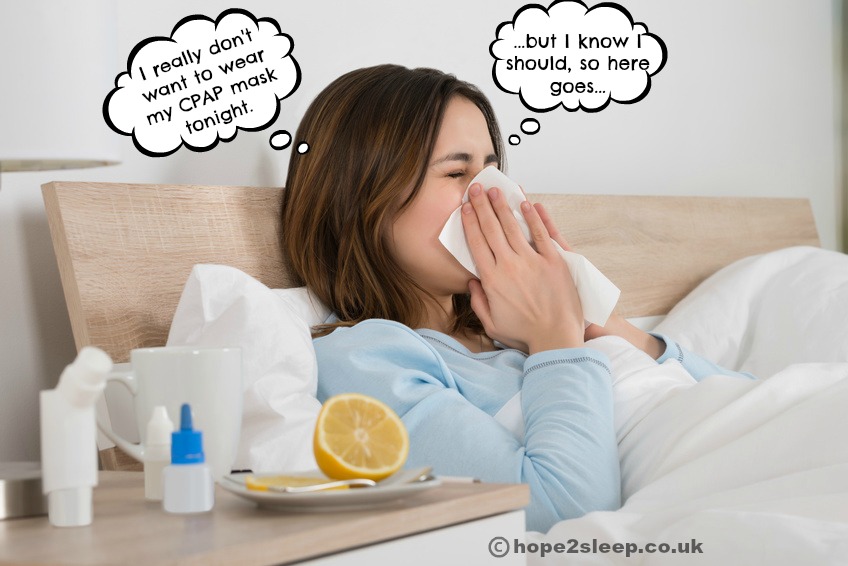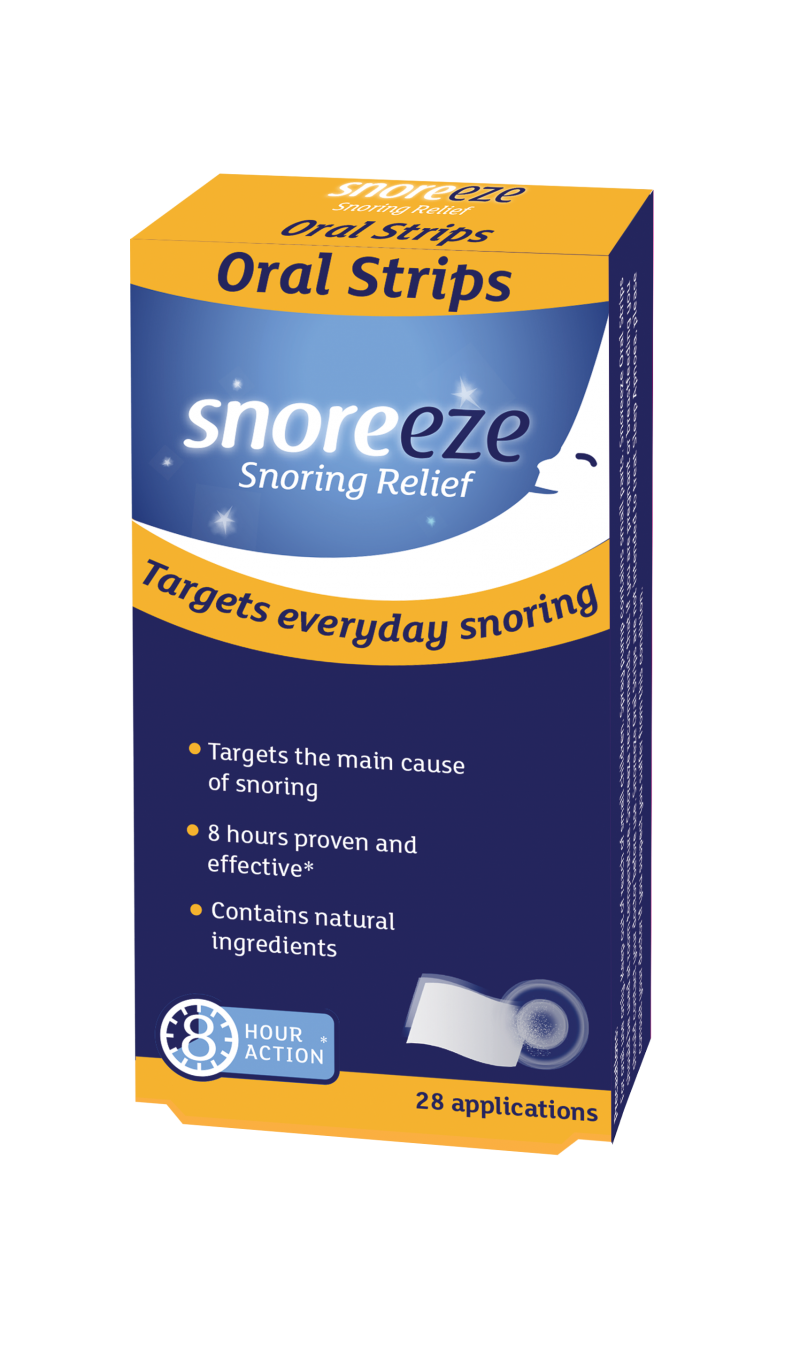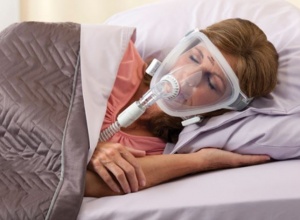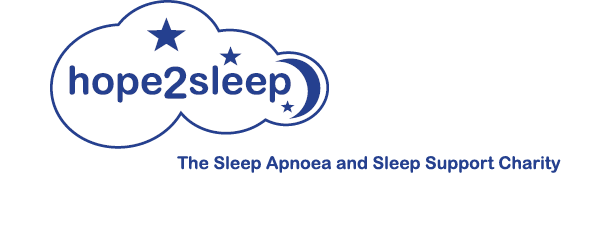Should We Use Our CPAP Masks With A Cold?
7 October 2016 | Kath Hope

My reason for writing this post just now, is because since I got diagnosed with sleep apnoea and went on therapy, I can't even remember a time when I've had such a bad cold as the one I've currently got - yet before I got diagnosed I was always ill with colds, throat and chest infections and also usually needed more than one course of antibiotics to clear any infection. In fact I remember in the early days going to a sleep apnoea support group meeting and the consultant asked for a show of hands from people who noticed they had less colds and infections since being treated for their sleep apnoea...... almost every hand in the room went up! There are always exceptions of course, and if some people find this is happening even more since using their machines, then the reason needs investigating, but before doing this check that the filters on the machine are up to date. Also make sure any left over water in the humidifier is thrown away, the chamber washed daily and fresh water put in just before bedtime, as used water is a perfect breeding ground for bacteria - as is a dirty mask!
Anyway, back to me.... setting up this charity was a long journey with lots of hard work, and I had to go to London last week, followed by another trip to Scotland, so I guess I pushed myself too hard, and despite good sleep therapy (perhaps not always enough hours lately though  ) my resistance was low and the dreadful cold attacked and won! Without exaggerating it has almost felt like flu symptoms, so here I am..... having to take the advice we give to others which is why I wanted to share it wider due to winter now settling in here in the UK:-
) my resistance was low and the dreadful cold attacked and won! Without exaggerating it has almost felt like flu symptoms, so here I am..... having to take the advice we give to others which is why I wanted to share it wider due to winter now settling in here in the UK:-
- Place Olbas Oil or Vicks on a tissue and put it near the air inlet at the back of the CPAP or ventilator, so that the aromas gently drift into the mask to help us breathe better. However, DO NOT place any substance on the filter of the machine or inside the humidifer chamber!! There are clear warnings in the manufacturers' handbooks about this, and we've come across people who have placed menthol crystals inside the humidifier and actually ended up cracking the glass!
- Nasal strips placed on the bridge of the nose (which can be bought on at the local chemist/supermarket or we supply the Latex-free Nasal Strips) help to open up the nasal passages, and in fact many people (like me) use these all the time, whether we have a cold or not. The Snoreeze Oral Strips that are really meant to target snoring by lubricating the soft tissue at the back of the throat can also help many people.


- A hugely successful tip, even though some people say this is an 'old wives tale,' is rubbing Vicks on the soles of the feet before bed, and preferably covering with a pair of socks. This usually achieves great results - especially if people are coughing a lot. You will find lots of articles on the internet about this and here's just one of them, both positive and negative and when we've recommended this one, many people have been skeptical, but in desperation people will try anything to sleep better. Almost every time, people come back to us in shock to report how much this helped, and bear in mind this is from people who doubted this 'old wives tale.'
- For people using a nasal mask, this is going to be even more challenging, so if at all possible try to get a mask that covers the mouth as well as the nose, so that when nasal breathing is a problem, at least you have the back up of mouth breathing which is less lik
 ely to disturb your sleep further. One of my favourite masks for my own issues is the total face Respironics' FitLife, and whilst it is one of the most expensive masks on the market, it's a really good mask for times when people have colds or any reason (like tooth ache, neuralgia, post nasal surgery etc) as the mask doesn't come into contact with the middle section of the face due to it sealing around the outer perimeter. Another option would be to get a cheaper full face mask like the Lowenstein Cara Full Face Mask to have as a back-up.
ely to disturb your sleep further. One of my favourite masks for my own issues is the total face Respironics' FitLife, and whilst it is one of the most expensive masks on the market, it's a really good mask for times when people have colds or any reason (like tooth ache, neuralgia, post nasal surgery etc) as the mask doesn't come into contact with the middle section of the face due to it sealing around the outer perimeter. Another option would be to get a cheaper full face mask like the Lowenstein Cara Full Face Mask to have as a back-up.
- CPAP and Ventilator Humidifiers are very helpful at times like this, and if you have one then you might like to increase the humidity setting. (If you have asthma as well, be cautious about this though as occasionally too much humidification can worsen asthma). Also bear in mind that with raising the humidifier setting, it's possible that 'rainout' can occur (water collecting in the hose and dripping into the mask) but there are solutions for this if you check out the Tips for Sleeping with CPAP or NIV section on the website.
- Due to more mouth breathing, a dry mouth can still be a problem even with a humidifier. It's no use giving our usual advice about keeping the mouth closed or using a chin strap when people have a cold, due to the nasal stuffiness, so trying a product like the Xylimelts Dry Mouth Discs (which have the best reviews for tackling dry mouth) or a dry mouth spray or gel.
- It's a well known fact that side sleeping is better for people with sleep apnoea, but it's even more important during times of congestion to get off your back. Also many people find it helpful to sleep slightly propped up with extra pillows, although be careful about having the neck angled causing the head to droop down as this can close the airways more.
So 3 days later, how do I feel? I'm well and truly on the mend now (fingers crossed) which I put down to managing to continue with good sleep apnoea therapy - rested sleep and healthy oxygen levels, which our bodies need to recover from anything. Years ago I'd have been totally knocked out by a virus such as this and would have needed one or two courses of antibiotics - plus I'd have been using my Ventolin inhaler (which by the way I haven't needed since I went on CPAP, although I don't kid myself this isn't the same for everyone).
I hope this article helps others when the nasty flu/cold viruses strike, and remember that using a mask during times like this is definitely harder, but worth it if it means we can recover quicker!
Do feel free to comment with your own tips that have helped you and may also help others.
Best Wishes for Good Safe Sleep.
Kath Hope













